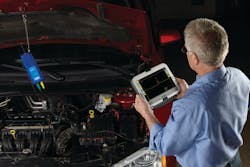CUSTOMER CONCERN:
Vehicle misfires
VEHICLE APPLICATIONS:
2006 Scion xB
Tests/Procedures for C.O.P. ignition diagnostics:
- Use a scan tool to check which cylinder is setting the DTC.
- If possible, use misfire counter on Mode 6 or in the OEM enhanced section of the scan tool to count misfires per cylinder.
- Test the suspect ignition coil using a labscope or C.O.P. tester.
- Swap coils and see if the misfire changes cylinders.
TOOLS USED:
- Scan tool
- Labscope
- Compression gauge
- Wiring diagrams
- C.O.P. tester
Fuel injectors do not go bad like they used to and engines routinely last 200,000 miles when maintained properly. Usually, when a misfire occurs on a vehicle these days, the easy assumption to make is to replace the coil in the cylinder setting the misfire DTC.
However, the PCM might misinterpret the CKP sensor and set a misfire DTC for the wrong cylinder. Furthermore, bad engine compression and irregular injectory spray patters can affect ignition in the cylinder.
Thankfully, with the right tools and techniques, ignition misfires can be diagnosed with almost 100 percent certainty rather quickly.
2006 Scion xB bad ignition coil
Unlike Fords, Toyotas are not quite so notorious for bad ignition coils. So, when one of these vehicles rolls into the shop with a misfire, you probably assume the vehicle needs spark plugs. This is because customers presume their Scions are like most other vehicles and only need spark plugs once every 100,000 miles, as opposed to 30,000 miles such as their factory maintenance schedules call for.
What do you do if after the "tune up" the misfire remains? The following steps cover how to quickly discern the cause of the misfire.
1. Check which cylinder is misfiring
Using a scan tool, check the misfire DTC. Depending on the scan tool (and vehicle) you might be able to count misfires using Mode 6, as seen in Fig. 1. On some vehicles, a relative compression, cylinder power balance and fuel injector flow test can be done with a click of a button. These tests help the technician quickly find out which cylinder is misfiring and depending upon the bidirectional controls offered by the scan tool, narrow down if the misfire is caused by an ignition, fuel or mechanical issue.
2. Test the suspect ignition coil
Testing ignition coils is an uncomplicated process, though ignition waveform interpretation can be quite complicated. For reasons of space, we are not going to discuss every nuance of interpretting an ignition waveform. Instead, we will cover both the old school and new school in ignition diagnostics.
Old school. You will need a labscope, wiring diagram and a T-pin to diagnose ignition the old school way. With the vehicle off, use a wiring diagram to find out which wire on the harness is the ground to the ignition coil, such as that in Fig. 2. Then, simply slide the T-pin into where the ground wire merges into the connector. (See Figs. 3A and 3B.)
It should be noted that if you do not have access to an accurate wiring diagram, simply keep putting the T-pin into a different wire until you get an ignition signal with the vehicle running. You will get a waveform on both the ground and power sides of the ignition circuit, so it is a matter of preference which side you choose.
Do this to each coil using different leads so you can compare ignition waveforms from different ignition coils. The more channels your labscope has, the better.
As Figs. 4 to 6 show, an ignition waveform looks different on different OEM applications. However, you generally do not need to memorize a known good waveform. A bad coil will simply stick out like a sore thumb, looking different than the other ignition coils. Even in Figs. 7 to 8, where not a single coil looks alike, the one that was misfiring has much more voltage and it matches up with the msifire DTC on the scan tool.
It is important to note that when looking at an ignition waveform, the large spike in the beginning of the waveform is the firing voltage. On a current waveform, the waveform will be at its lowest point, because as voltage increases amperage falls.
The long line of voltage follwing the firing voltage is the firing time, which is the time elapsed when the spark is actually occurring. Differences in firing voltage and other parts of the waveform reflect conditions in the cylinder.
New school. Don't feel like looking up wiring diagrams or hooking stuff up? Simply use a GTC SmarTach+ COP tester. (See Figs. 9 and 10.) By placing its probe on the top of an ignition coil, it instantly gives an engine RPM, burn time and coil kV reading. So, instead of comparing waveforms, you simply comprare burn time and coil kV between coils.
This method can also be used to check misfirng cylinders on vehicles that use spark plug wires. The probe can be pointed at different spark plug wires. All the technician needs to do is compare results.
3. Swap coils and test again.
It is important to note that regardless of whether you are diagnosing ignition the old or new school way, ignition is always affected by conditions in a cylinder. So, low cylinder compression from a washed down cylinder can make a good coil look bad. (See Fig. 11.)
Simply swap a known "good" coil with the suspect one, and check again your readings. If the misfire changes cylinders, simply replace the suspect ignition coil. If it doesn't, the vehicle has a fuel or mechanical problem in that cylinder.
Presuming the reading does not change, the next step would be to remove the spark plug and do a compression test. If the vehicle does not have a dead misfire, it might be wise to check timing with a pressure transducer or do a cylinder leak down test. Now, if everything checks out, it is time to start testing the fuel injectors.
As for this 2006 Scion xB, the misfire changed cylinders, so it was fixed with a new coil.

